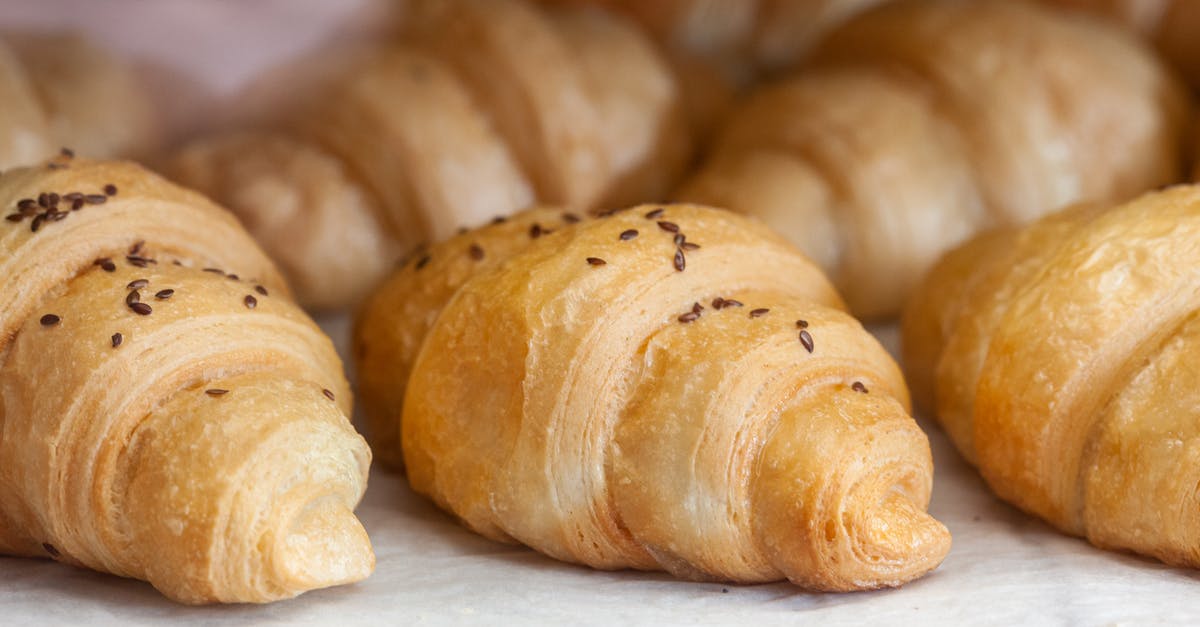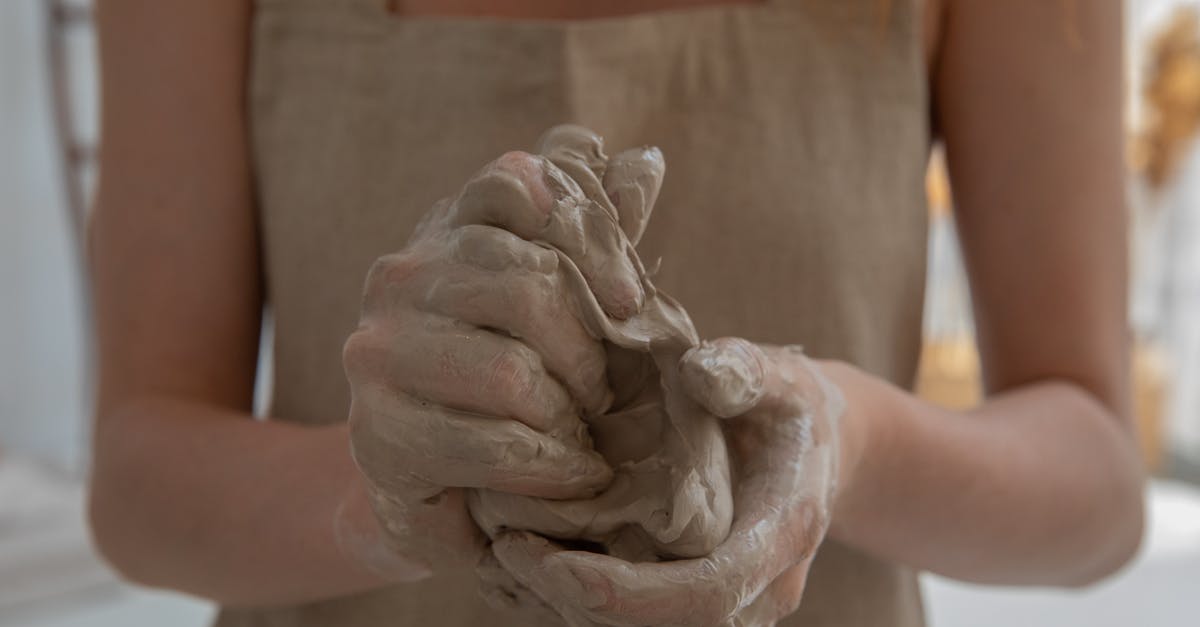What techniques or tricks make soft, flaky pastries instead of leathery ones?

These are my first experiences with the lovely pastry, puff pastry.
 I loved it so much that I'd bake more and more of it everyday. The only problem I encountered is that my pastries had a tough crust and they'are somehow leathery, having a tough, hard texture. After a day, it's unpalatable. What techniques or tricks make puff pastry soft, flaky instead of leathery? Please tell me about your own experiences too.
I loved it so much that I'd bake more and more of it everyday. The only problem I encountered is that my pastries had a tough crust and they'are somehow leathery, having a tough, hard texture. After a day, it's unpalatable. What techniques or tricks make puff pastry soft, flaky instead of leathery? Please tell me about your own experiences too.
Note: Left picture is Sunny-Side-Up Apricot Pastries – Michel Richard. Right picture is Puff Pastry – Michel Richard and I think the amounts are a little off since one cup of water is not enough at all for that much flour.
Best Answer
There are two ways that I make puff pastry. The first is Rough Puff Pastry which is a quicker way to make puff pastry and you get about 75% of the rise you get with normal puff pastry.
Here is a link for a Rough Puff Pastry that I use. I'd say that the most important tips to take from that recipe is that the butter must be cold when you start and make sure you're using really cold water to mix in. Using a knife instead of your hands is also a good idea to stop your hands melting the butter too much - you want to see the pieces of butter in your pastry. Making sure you chill the pastry after folding for an hour or as long as you can.
Secondly, to make 'real' puff pastry, you need to have to plan in advance as it is going to require a lot of chilling. Firstly, make your dough separately, roll in a ball and chill overnight. Then roll out your butter and make sure you then chill the rolled out butter again. You then continue with the folding and chilling as before. Again, the most important thing here is to chill for at least an hour in between the folds. This ensures that the layers of butter and pastry build up, and that is what gives you the best rise and the flakes you are after. Here is a good recipe that I use with lots of other tips and tricks in.
From looking at your pictures, in my opinion, the 'leatheriness' you are seeing looks like the pastry is a little under baked. The 'tough crust' looks to me like there aren't many layers of butter towards to the top of your pastry which is why it hasn't puffed out when it's been baked. Definitely try following one of the above recipes - if only to get the technique right - and go from there. I definitely find the trick is lots of chilling and keep everything cold! I sometimes even chill the flour!!
Pictures about "What techniques or tricks make soft, flaky pastries instead of leathery ones?"



What makes pastry tender and flaky?
Flakiness comes from the solid fat (butter, shortening, lard, or cream cheese) that's used to make the dough. The fat is mixed or \u201ccut\u201d into the flour so it stays in discernible pieces. During baking, the pieces of fat melt away, leaving air pockets that then expand a little from steam.What creates the flaky texture for puff pastry?
Puff pastry's final quality is dependent on how well the lamination process is carried out. The formation of crisp and flaky texture is caused by the vapor generated from the dough during baking and further entrapment by the fat layers.How do you keep pastry soft?
Keeping Pastry Fresh For 24-48 HoursPutting them in paper first rather than directly inside the plastic helps them to retain their delicious crisp moisture without the sogginess that can be caused by condensation on the inside of a plastic bag.What are the three 3 methods of making puff pastry?
Commercial chefs commonly use one of three methods to incorporate fat into the dough. These are known as the French (Continental), English, and Scotch methods. The difference among these methods is the way that the fat is encased into the dough during the stages of rolling and folding.Succeeding with own made flaky Pastry
More answers regarding what techniques or tricks make soft, flaky pastries instead of leathery ones?
Answer 2
I think I know exactly what your problem with this pastry has been. You alluded to it here: Would this cheat puff pastry really work? I stressed in my answer to that question that the butter must be kept cold while making the pastry and up to the point that you put it in the oven. I'm nearly certain that keeping your dough cold enough has been your problem.
The best solution I have seen for that difficulty is also in that question. That method by Paul Hollywood is outstanding. Do just what he says. I bet it will work beautifully for you.
Answer 3
My approach to pastry (and cooking in general) is "science-y" -- in order to replicate a recipe, I want to understand the techniques being applied and moreover how the techniques produce the intended result. It sounds like you're serious about this, so this is how I'd approach the situation. I hope this is helpful, and not too wordy! Full disclosure: I'm no pastry chef, but I can make a passable croissant. :) I welcome commentary or correction!
Though it seems like you're already doing fine with the process of creating the dough, I'm going to start with my take on pastry dough technique as a basis for what might be going awry.
When I heard the word "laminated dough" when referring to the many layers of pastry, the process started to click for me. I really enjoy this article, which describes the fundamentals of creating laminated dough for pastries. It is a different take that emphasizes the why of the process (from the more procedural articles that @WilliamMoore linked, which seem decent but less helpful for my goals). Lamination can apply both to "rough" (more toward biscuit or pie crust) and proper "puff" pastry, but I'm focusing on the latter (e.g., croissant).
The concept is relatively straightforward: you are trying to create a lot of uniform-thickness layers (the "lamination" process) of dough-butter-dough-butter-dough-butter-... as many layers as you want, by creating a package of butter wrapped in dough (initially, this is 3 layers of dough-butter-dough; that is, one brick of butter encased in dough; I like the envelope-shape encasement strategy as in the article). Then roll flat and thinner, then fold in thirds (like a letter to put into an envelope) to create many layers. Chill between "turns" (roll+fold cycles) to make the whole package easier to work with and behave properly. Your CWtM article says basically the same, but I wouldn't do so many "turns" in a row without chilling between.
The purpose of trying to get the butter in very many tiny layers, as I understand it: as the pastry cooks, the water will boil (steam), creating a leavening effect and separating the layers, and the fat will melt into the flour layers and turn golden and delicious. It's brilliant! Each impossibly thin layer of flaky goodness in a croissant (for example) is from one layer of that laminated dough. This, I think, is what's causing the texture that you're not liking: non-uniform layers, regardless of whether it's temperature, technique, or something else that's causing it.
The (linked) JoePastry article says the magnitude you're looking for: up to 2187 layers! The scientist in me is forced to describe that number: it's 37 (three-to-the-seventh-power). The other numbers on the page are other 3^N, for some N. To get 2187 layers, you have to roll+fold+chill seven times. Every subsequent time you fold into thirds, you (hope to!) get three times the number of layers you had previously (3*3*3*...). Chilling between folds helps the layers stay intact, and gives the dough time time to relax (e.g., gluten) after flattening. Because you start with dough-butter-dough, the layers will in fact be after the second stage (after folding): (flour) dough-butter-dough (flour) dough-butter-dough (flour) dough-butter-dough (flour) -- 9, that is 32. The (flour) being just enough bench flour to make the thing not stick to your work-surface.
I wish the (linked) JoePastry article would emphasize more the importance of appropriate temperature of the initial ingredients, that @WilliamMoore emphasizes in his answer. Butter that is too warm will melt into the flour (or squidge out the sides), leaving you with an oily mess that is closer to roux than dough. On the other hand, if your butter is too cold, it will be impossible to work, and as you try to fold, the butter will remain as a brick and press through your dough, giving you "icebergs" of butter or uneven layers (JP suggests 20min on the counter to soften).
So, now to answer your question:
- As @William says, make sure your ingredients are the appropriate temperature. If your butter starts melting, you're going to get more toward a pie-crust and maybe "rubbery" consistency. But if your butter is too hard, it will form chunks and punch through your other layers as you repeatedly roll-and-fold.
- Try to make your layers be more uniform. Temperature, uniformity of rolling, patience to wait 15-20 mins of refrigeration between folds, and precision will help. You'll get a "lighter" (as light as butter and flour could be...) consistency with very uniform layers, that will puff up better.
- Try more layers. JP says 81 (34, so 4 roll+fold+chill cycles), but experiment with even more. You may be able to compensate for some non-uniformity by another "turn".
Now some more "experimental" thoughts:
- Roll the initial packet of dough (and butter) thinner. Try to get the thickness of the dough and of the butter to be the same. Stack them and trim edges. Roll gently and refrigerate before the initial turn (roll+fold).
- Play around with the temperature of the butter so that its consistency is the same as the dough. The idea is that equal pressure on the dough and on the butter have similar effect when you're rolling: you want to squash the whole layer "cake" uniformly; if you start with a dough of a certain thickness, and roll it out to half that thickness, ideally EVERY layer would be squashed uniformly to half of its original thickness. This is unreasonable to expect, but the ideal scenario. At the end, ideally, all 81 (or whatever) layers would be of equal thickness.
- Cut off some bits at the sides. The sides will necessarily be the least uniform parts of the dough. You might even go so far as to cut and stack (rather than fold), which will give you marginally better margins. Pastry making is not without waste. For examples, watch Kings of Pastry.
Two of my own failures were from wrong-temperature butter:
- too cold, and the butter forms "iceberg-like" chunks in the dough, which poke through other layers. Stuff starts sticking to the rolling pin and it's all over.
- too warm, and I got pie crust instead of croissant. Still delicious, but not what I was aiming for. :)
You're aiming for absolutely uniform thickness in all of your 81 to 2187 layers. I expect this comes with luck and about 25 years experience making pastry, neither of which I have. The first "turn" is crucial in this process. If you can get one uniform layer of butter in the first roll, you've done better than I ever have; however, I think this is what we're aiming for.
You also say "after a day" -- no self-respecting French pastry shop would sell croissants that are a day or more old; like baguettes, they'll go stale in hours. No self-respecting home cook would make croissants every day, so you've got yourself some decisions. :) Freezing the pastry dough then cooking in small batches might work, as suggested in the JP article.
Does this kind of "science-y" approach work for you? If these don't sound appealing, can you describe your technique further? This is about 10x longer than I hoped, but I enjoy this kind of stuff!
Answer 4
The prime culprit for toughness in my pastries is too much gluten development. Usually this occurs for me through one of the following:
- overhandling or kneading the dough. Technically, every time you rearrange the dough.
- too much time between mixing and oven. Gluten develops all by itself - albeit very slowly.
- too high a ratio of gluten to water. This could be too much flour relative to water, as you mentioned (drier doughs develop gluten much more quickly than wet ones), as well as the type of flour you used having too much protein for pastry, such as bread flour vs pastry flour.
I notice the recipe you linked measures in volume. Further to the idea about too much flour, 2 1/2 cups of flour can vary hugely depending on how compacted your (and their!) flour is. You could try two things: do exactly the same thing you did last time, then remove a few tablespoons of flour; OR try looking for another pastry dough recipe that uses weight measurements, and then measure everything out on a scale.
Answer 5
Go to the supermarket and just buy a pack of filo pastry sheets. Filo pastry if applied properly will definitely make it flaky and soft.
Sources: Stack Exchange - This article follows the attribution requirements of Stack Exchange and is licensed under CC BY-SA 3.0.
Images: Klaus Nielsen, Julia Filirovska, Monstera, Monstera
